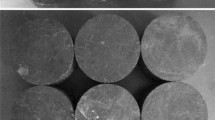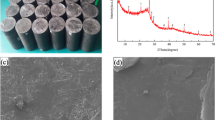Abstract
Most coal reservoirs in China have low permeability, which causes gas drainage to be inefficient. The method of cyclic cryogenic fracturing basing on freezing–thawing (F–T) fracturing effects is proposed to break coal to increase its permeability. An F–T experiment was carried out at different freezing temperatures using a nuclear magnetic resonance (NMR) test and an ultrasonic test. We investigated the evolution of coal pore structure under different freezing temperature F–T cycles and the mechanism of F–T fracturing. The results indicate that the frost force and the thermal stress in the cyclical process of F–T work together to cause fracture formation and fatigue damage. When the freezing temperature decreases, the network of pores and fissures becomes more developed and the number of mesopores, macropores and micro-fractures increases. This suggests that the network of pore-fractures in coal will be more interconnected and the space available for gas seepage will be larger. Ultimately, this significantly increases the efficiency of gas drainage.












Similar content being viewed by others
References
Altindag R, Alyildiz IS, Onargan T (2004) Mechanical property degradation of ignimbrite subjected to recurrent freeze-thaw cycles. Int J Rock Mech Min 41(6):1023–1028
Cai C-Z, Gao F, Li G-S, Huang Z, Hou P (2016) Evaluation of coal damage and cracking characteristics due to liquid nitrogen cooling on the basis of the energy evolution laws. J Nat Gas Sci Eng 29:30–36
Del Rio LM, Lopez F, Esteban FJ et al (2005) Ultrasonic study of alteration processes in granites caused by freezing and thawing. In: Ultrasonic dymposium. New York, Ieee, pp 419–422
Frosch GP, Tillich JE, Haselmeier R, Holz M, Althaus E (2000) Probing the pore space of geothermal reservoir sandstones by nuclear magnetic resonance. Geothermics 29:671–687
Javadpour F, Mcclure M, Naraghi ME (2015) Slip-corrected liquid permeability and its effect on hydraulic fracturing and fluid loss in shale. Fuel 160:549–559
Jia H-L, Xiang W, Tan L et al (2016) Theoretical analysis and experimental verifications of frost damage mechanism of sandstone. Chin J Rock Mech Eng 35(05):879–895
Khandelwal M, Singh TN (2009) Correlating static properties of coal measures rocks with P-wave velocity. Int J Coal Geol 79(1–2):55–60. (at shallow depths. Journal of Applied Geophysics 2014, 109, 27–35)
Li J-L (2012) Experimental study on deterioration mechanism of rock under the conditions of freezing–thawing cycles in cold regions based on NMR technology. Central south university, Changsha
Li J-L, Zhou K-P, Zhang Y-M et al (2012) Experimental study of rock porous structure damage characteristics under condition of freezing–thawing cycles based on nuclear magnetic resonance technique. Chin J Rock Mech Eng 31(06):1208–1214
Li Z-F, Xu H-F, Zhang C-Y (2016) Liquid nitrogen gasification fracturing technology for shale as development. J Pet Sci Eng 138:253–256
Ni X-M, Li Q-Z, Wang Y, Gao S (2015) Permeability variation characteristics of coal after injecting carbon dioxide into a coal seam. Int J Min Sci Technol 25:665–670
Qin L, Zhai C, Liu S-M et al (2016) Failure mechanism of coal after cryogenic freezing with cyclic liquid nitrogen and its influences on coalbed methane exploitation. Energy Fuels 30(10):8567–8578
Ren S-R, Fan Z-K, Zhang L et al (2013() Mechanisms and experimental study of thermal-shock effect on coal-rock using liquid nitrogen. Chin J Rock Mec Eng 32(S2):3790–3794
Sass O (2004) Rock moisture fluctuations during freeze-thaw cycles: preliminary results from electrical resistivity measurements. Polar Geogr 28:13–31
Sondergeld CH, Rai CS (2007) Velocity and resistivity changes during freeze-thaw cycles in Berea sandstone. Geophysics 72(2):E99–E105
Sun M-Y (2005) Current status and prospects of CBM industry in China. China Coalbed Methane 2 (03):3–5
Taber S (1929) Frost heaving. J Geol 37:428–461
Talabi O, AlSayari S, Iglauer S, Blunt MJ (2009) Pore-scale simulation of NMR response. J Petrol Sci Eng 67:168–178
Wyllie MRJ (1956) Elastic wave velocities in heterogeneous and porous media. Geophysics 21(1):41–70
Wyllie MRJ, Gregory AR, Gardner GHF (1958) An experimental investigation of factors affecting elastic wave velocities in porous media. Geophysics 23(3):459–493
Yao Y-B, Liu D-M, Xie S-B (2014) Quantitative characterization of methane adsorption on coal using a low-field NMR relaxation method. Int J Coal Geol 131:32–40
Zhai C, Qin L, Liu S-M et al (2016) Pore structure in coal: pore evolution after cryogenic freezing with cyclic liquid nitrogen injection and its implication on coalbed methane extraction. Energy Fuels 7(30):6009–6020
Zhang J-B, Wu C-F (2012) Application status and improvement of coal bed methane development technology. Coal Sci Technol 40(08):88–91
Zhou Q-C (2006) Study on the mechanical property of a sandstone under geothermal-mechanical and hydraulic-mechanical coupling. Institute of rock & mechanics, Chinese academy of science, Beijing
Zhou L-G, Wu C-F (2012) Pore characteristics of the main coal seams in Bide-Santang Basin in Western Guizhou Province. J China Coal Soc 37(11):1878–1884
Acknowledgements
This work was financially supported by the National Natural Science Foundation of China (51774278, 51274195, U1361106), the Natural Science Foundation of Jiangsu Province (BK20170001), the National Major Scientific Instrument and Equipment Development Project (2013YQ17046309).
Author information
Authors and Affiliations
Corresponding author
Rights and permissions
About this article
Cite this article
Sun, Y., Zhai, C., Qin, L. et al. Coal pore characteristics at different freezing temperatures under conditions of freezing–thawing cycles. Environ Earth Sci 77, 525 (2018). https://doi.org/10.1007/s12665-018-7693-y
Received:
Accepted:
Published:
DOI: https://doi.org/10.1007/s12665-018-7693-y




